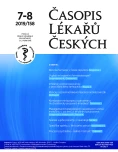Sleep and its disturbances in neurology
Authors:
Karel Šonka
Authors‘ workplace:
Neurologická klinika a Centrum klinických neurověd 1. LF UK a VFN v Praze
Published in:
Čas. Lék. čes. 2019; 158: 318-320
Category:
Review Article
Overview
Sleep disturbances are important symptoms of neurological diseases and some so-called primary sleep disorders have a neurological nature. The development of medicine, the availability of sleep investigations and progress in the treatment of sleep disorders have caused that the care of neurological illness includes sleep-related problems. In addition, sleep disorders can be risk factors for neurological diseases (for example obstructive sleep apnea for stroke) or their prodromal stage (REM sleep behavior disorder is one of the first symptoms of synucleinopathies). The article gives a very brief overview of sleep disorders in relation to neurological diseases and vice versa.
Keywords:
sleep – sleep disorders – Neurology
Sources
1. Nevšímalová S. Spánková medicína v odkazu doc. MUDr. Bedřicha Rotha, DrSc. Časopis lékařů českých 2019; 158: 167–169.
2. American Academy of Sleep Medicine. International classification of sleep disorders (3rd ed.). American Academy of Sleep Medicine, Darien, 2014.
3. Szabo ST, Thorpy MJ, Mayer G et al. Neurobiological and immunogenetic aspects of narcolepsy: Implications for pharmacotherapy. Sleep Med Rev 2019; 43: 23–36.
4. Roth B. Spánková opilost a spánková obrna. Československá neurologie 1956; 19(1): 48–58.
5. Šonka K, Šusta M, Billiard M. Narcolepsy with and without cataplexy, idiopathic hypersomnia with and without long sleep time: a cluster analysis. Sleep Med 2015; 16(2): 225–231.
6. Ruoff C, Pizza F, Trotti LM et al. The MSLT is repeatable in narcolepsy type 1 but not narcolepsy type 2: a retrospective patient study. J Clin Sleep Med 2018; 14(1): 65–74.
7. Šonka K. Pharmacological treatment of excessive daytime sleepiness. In: Overeen S., Reading P (eds.). Sleep disorders in neurology. A practical approach (2nd ed.). John Wiley & Sons, Oxford, 2018: 73–82.
8. Cochen De Cock V, Bayard S, Jaussent I et al. Daytime sleepiness in Parkinson's disease: a reappraisal. PLoS One 2014; 9(9): e107278.
9. Tholfsen LK, Larsen JP, Schulz J et al. Development of excessive daytime sleepiness in early Parkinson disease. Neurology 2015; 85(2): 162–168.
10. Chwiszczuk L, Breitve M, Hynninen M et al. Higher frequency and complexity of sleep disturbances in dementia with Lewy bodies as compared to Alzheimer's disease. Neurodegener Dis 2016; 16(3–4): 152–160.
11. Nevšímalová S, Bušková J, Brůha R et al. Sleep disorders in Wilson's disease. Eur J Neurol 2011; 18(1): 184–190.
12. Kimbrough DJ, Braley TJ. Sleep and multiple sclerosis. In: Miglis MG (ed.). Sleep and neurologic disease. Academic Press, London, 2017: 167–183.
13. Ferini-Strambi L, Lombardi GE, Marelli S, Galbiati A. Neurological deficits in obstructive sleep apnea. Curr Treat Options Neurol 2017; 19(4): 16.
14. Dostálová V, Kolečkářová S, Kuška M et al. Effects of continuous positive airway pressure on neurocognitive and neuropsychiatric function in obstructive sleep apnea. J Sleep Res 2019; 28(5): e12761.
15. Catalan-Serra P, Campos-Rodriguez F, Reyes-Nunez N et al. Increased incidence of stroke, but not coronary heart disease, in elderly patients with sleep apnea. Stroke 2019; 50(2): 491–494.
16. Slonková J, Bar M, Nilius P et al. Spontaneous improvement in both obstructive sleep apnea and cognitive impairment after stroke. Sleep Med 2017; 32: 137–142.
17. Šonka K, Juklíčková M, Pretl M et al. Seizures in sleep apnea patients: occurrence and time distribution. Sborník lékařský 2000; 101(3): 229–232.
18. Aboussouan LS, Mireles-Cabodevila E. Sleep-Disordered breathing in neuromuscular disease: diagnostic and therapeutic challenges. Chest 2017; 152(4): 880–892.
19. Radunovic A, Annane D, Rafiq MK et al. Mechanical ventilation for amyotrophic lateral sclerosis/motor neuron disease. Cochrane Database Syst Rev 2017; 10: CD004427.
20. Hiller AJ, Ishii M. Disorders of body weight, sleep and circadian rhythm as manifestations of hypothalamic dysfunction in Alzheimer's disease. Front Cell Neurosci 2018; 12: 471.
21. Allen RP, Walters AS, Montplaisir J et al. Restless legs syndrome prevalence and impact: REST general population study. Arch Intern Med 2005; 165(11): 1286–1292.
22. Vávrová J, Kemlink D, Šonka K et al. Restless legs syndrome in Czech patients with multiple sclerosis: an epidemiological and genetic study. Sleep Med 2012;13(7): 848–851.
23. Moccia M, Erro R, Picillo M et al. A Four-year longitudinal study on restless legs syndrome in Parkinson eisease. Sleep 2016; 39(2): 405–412.
24. Serranová T, Slovák M, Kemlink D et al. Prevalence of restless legs syndrome in functional movement disorders: a case-control study from the Czech Republic. BMJ Open 2019; 9(1): e024236.
25. Katsanos AH, Kosmidou M, Konitsiotis S et al. Restless legs syndrome and cerebrovascular/cardiovascular events: systematic review and meta-analysis. Acta Neurol Scand 2018; 137(1): 142–148.
26. Schenck CH, Bundlie SR, Ettinger MG, Mahowald MW. Chronic behavioral disorders of human REM sleep: a new category of parasomnia. Sleep 1986; 9(2): 293–308.
27. Postuma RB, Iranzo A, Hu M et al. Risk and predictors of dementia and parkinsonism in idiopathic REM sleep behaviour disorder: a multicentre study. Brain 2019; 142(3): 744–759.
Labels
Addictology Allergology and clinical immunology Angiology Audiology Clinical biochemistry Dermatology & STDs Paediatric gastroenterology Paediatric surgery Paediatric cardiology Paediatric neurology Paediatric ENT Paediatric psychiatry Paediatric rheumatology Diabetology Pharmacy Vascular surgery Pain management Dental HygienistArticle was published in
Journal of Czech Physicians

Most read in this issue
- Medication treatment of singultus in palliative care
- Intrapleural alteplase therapy: what are the knowns and unknowns?
- Sleep and its disturbances in neurology
- Proton pump inhibitors from clinical pharmacist’s point of view
